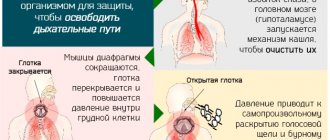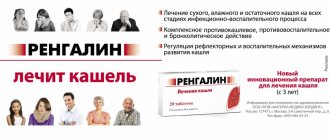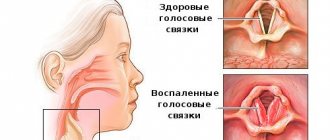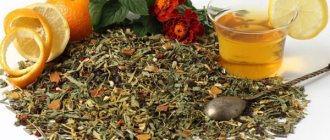Composition and release form
Lozenges - 1 tablet:
- active substances: antibodies to bradykinin, affinity purified - 0.006 g; affinity purified antibodies to histamine - 0.006 g; affinity purified antibodies to morphine - 0.006 g;
- excipients: isomalt - 0.506 g, MCC - 0.0275 g; magnesium stearate - 0.0055 g; anhydrous citric acid - 0.005225 g; colloidal silicon dioxide - 0.00275 g; sodium cyclamate - 0.00275 g; sodium saccharin - 0.000275 g.
Oral solution - 100 ml:
- active substance: affinity purified antibodies to bradykinin - 0.12 g; affinity purified antibodies to histamine - 0.12 g; affinity purified antibodies to morphine - 0.12 g;
- excipients: maltitol - 6 g; glycerol - 3 g; potassium sorbate - 0.165 g; anhydrous citric acid - 0.02 g; purified water - up to 100 ml.
Lozenges. In a blister pack made of PVC film and aluminum foil, 10 pcs. 1, 2 or 5 blister packs in a cardboard pack.
Oral solution. 100 ml in bottles made of OS brand glass or painted glass, sealed with tamper evident caps, with a PE dropper. Each bottle is placed in a cardboard pack.
pharmachologic effect
Antitussive.
Pharmacokinetics
The sensitivity of modern physicochemical methods of analysis (gas-liquid chromatography, high-performance liquid chromatography, gas chromatography-mass spectrometry) does not allow assessing the content of ultra-low doses of antibodies in biological fluids, organs and tissues, which makes it technically impossible to study the pharmacokinetics of the drug Rengalin.
Pharmacodynamics
It has been experimentally shown that the components of the drug modify the activity of the ligand-receptor interaction of endogenous regulators with the corresponding receptors: antibodies to morphine - with opiate receptors; antibodies to histamine - with H1-histamine receptors; antibodies to bradykinin - with B1 bradykinin receptors; in this case, the combined use of the components leads to an increase in the antitussive effect.
In addition to the antitussive effect, the complex drug, due to its constituent components, has anti-inflammatory, decongestant, antiallergic, antispasmodic (antibodies to histamine, antibodies to bradykinin) and analgesic effects (antibodies to morphine).
The complex drug Rengalin, due to modification of histamine-dependent activation of H1 receptors and bradykinin-dependent activation of B1 receptors, selectively reduces the excitability of the cough center of the medulla oblongata and inhibits the central parts of the cough reflex. By inhibiting pain sensitivity centers in the thalamus, it blocks the transmission of pain impulses to the cerebral cortex. Inhibits the flow of pain impulses from the periphery due to a decrease in the release of tissue and plasma algogens (including histamine, bradykinin, PG).
Facilitates the manifestations of acute pharyngitis, laryngitis and bronchitis, reduces bronchospasm.
Relieves systemic and local symptoms of allergic reactions by influencing the synthesis and release of histamine and bradykinin from mast cells.
What we are treated with: Rengalin
In another study, the authors did not neglect the comparison group: Ambroxol and Sinekod competed in curing cough in children with Rengalin. However, in the middle of the article there is an advertisement for Rengalin (for which the magazine was clearly paid), it was financed by the manufacturer, and there was no blinding in it. This means that when conducting the test, doctors knew who would get what, and could subjectively interpret or deliberately manipulate the result. Therefore, you should not trust it, although according to some formal indicators (p-value < 0.05) it looks decent.
An article in the journal Antibiotics and Chemotherapy describes a trial on 139 participants. Rengalin is compared here with Codelac and found to be comparable in effectiveness. True, problems with blinding do not go away. Moreover, the study included patients with a nonproductive cough that lasted at least 12 hours and no more than seven days! Thus, doctors could simply assign more people who had been coughing for a long time to the Rengalin group and receive a “magic” healing.
The fourth study did not go much further: at the conclusion of the article there is an advertisement for Rengalin. Despite the fact that the study is double-blind this time, it inspires little hope. “Over seven days of treatment, the severity of daytime cough decreased to 1.0±0.9 points in the Rengalin group and 1.2±0.9 points in the placebo group; night to 0.1±0.4 points and 0.3±0.5 points in groups, respectively” - such results cannot be called success. And if you look at the tables with these scores, you will find out that for some reason the placebo group has lower average scores, especially at first, but those who took Rengalin have huge standard deviations.
Indicator.Ru does not recommend: this is ordinary homeopathy
Rengalin is another creation that discredits the title of the work of Carl Linnaeus. For many, this information will already be a signal to stop reading and choose such a remedy for treatment. There is practically no active ingredient in tablets and solutions of this drug. At the same time, even if it existed, it could make it worse: treating a cough by suppressing the work of histamine, bradykinin and morphine is a pointless undertaking.
Despite registration and clinical trials, the drug has not proven its medicinal properties. Four articles about this medicine, published in low-rated Russian publications, are cheerfully interspersed with advertisements for Rengalin. Despite all the arguments of the authors and sometimes (but not always) beautiful numbers in statistics, it becomes clear why decent journals did not publish their work. We will not blame the manufacturers; let the reader draw the conclusions himself (or perhaps the investigative committee, as in Belarus).
Our recommendations cannot be equated with a doctor's prescription. Before you start taking this or that drug, be sure to consult a specialist.
Did you like the material? Add Indicator.Ru to “My Sources” of Yandex.News and read us more often.
Subscribe to Indicator.Ru on social networks: Facebook, VKontakte, Twitter, Telegram, Odnoklassniki.
Rengalin dosage
Inside, outside of meals.
For one appointment - 1 tablet. (keep in mouth until completely dissolved) or 1–2 teaspoons (5–10 ml). It is advisable to keep the solution in the mouth before swallowing for maximum effect of the drug.
Take 1-2 tablets. 3 times a day or 1–2 teaspoons of solution 3 times a day. Depending on the severity of the condition, in the first 3 days the frequency of administration can be increased to 4-6 times a day. The duration of therapy depends on the severity of the disease and is determined by the attending physician.
Cough ranks high among the symptoms caused by pathology of the respiratory system. It should be considered not as a pathological symptom, but as a protective reaction of the body that creates optimal conditions for a person to exist. Nevertheless, quite often cough loses its physiological purpose, becomes chronic and turns into a factor that significantly reduces the patient’s quality of life [1, 2].
Depending on the duration of the cough, it can be acute, protracted or chronic. The most common causes of acute cough
are upper respiratory tract infections such as acute respiratory viral infections (ARVI), acute bacterial rhinosinusitis, whooping cough, exacerbation of chronic obstructive pulmonary diseases, allergic rhinitis. The most common cause of acute cough is viral infections of the upper respiratory tract. In patients with ARVI without treatment, the frequency of this symptom in the first 48 hours of the disease reaches 83%, and by the 14th day it decreases to 26%. Cough during ARVI is stimulated by the drainage of secretions from the nasopharynx and irritation of the mucous membrane of the pharynx and larynx. With adequate treatment for ARVI, the cough goes away without a trace. However, situations arise when the cough becomes protracted.
Persistent cough
most often begins with an upper respiratory tract infection and lasts from 3 to 8 weeks; most often it is so-called post-infectious, or serves as a manifestation of bacterial rhinosinusitis or asthma [3].
Chronic cough.
A common cause of chronic cough is smoking, which has a direct irritant effect on the cough receptors of the respiratory tract, and also causes irritation and an inflammatory reaction in the mucous membrane of the tracheobronchial tree. Other causes of chronic cough are:
1. Syndrome of postnasal drip of mucus into the throat due to rhinitis or sinusitis. The term “postnasal drip syndrome” (PNS) refers to clinical situations characterized by an inflammatory process in the upper respiratory tract (nasopharynx, nose, paranasal sinuses (NS)), in which discharge from the nose flows down the back wall of the pharynx into the tracheobronchial tree.
2. A special variant of bronchial asthma, which is manifested by coughing without suffocation, often at night. The so-called “cough bronchial asthma” accounts for 20-28% of all cases of chronic cough.
3. Gastroesophageal reflux (gastroesophageal reflux disease). It is believed that in more than 20% of patients with chronic cough, the cause of the latter is gastroesophageal reflux.
4. Cough often becomes a side effect when taking angiotensin-converting enzyme (ACE) inhibitors in the treatment of patients with arterial hypertension and circulatory failure. This is due to the accumulation of bradykinin, which adversely affects the bronchi. It is noted that not all ACE inhibitors have this side effect equally. Cough occurs much less frequently when using pyrindopril (Prestarium) and monopril [1].
In most cases, the occurrence of cough is associated with pathology of the respiratory system. However, there are types of it in which there is no pathology in the respiratory tract. It's reflexive
and
neurogenic
cough.
When treating cough, it is necessary to take into account its etiology, course and nature.
The most effective is etiotropic therapy, which involves either eliminating the cause of the cough or eliminating the pathological process that led to the cough. In cases where etiological and pathogenetic therapy for one reason or another is impossible or not effective enough, symptomatic therapy of cough is carried out. The choice of medications depends primarily on the nature of the cough, its intensity and other characteristics.
Today, in the pharmaceutical reference book you can find several dozen drugs that have an antitussive effect, among which traditionally there are antitussives of central and peripheral action, drugs with an indirect antitussive effect (bronchodilators, anti-inflammatory, antiallergic, decongestants, etc.), as well as combined drugs.
Such an abundance of proposed remedies for the treatment of cough is due, on the one hand, to the need to solve various therapeutic problems depending on the nature of the cough, the stage of the infectious process and the combination of certain pathological factors underlying it, and on the other hand, the insufficient effectiveness of the therapy. According to the literature, 36% of patients consider the cough medications they take to be useless; 57% note a slight therapeutic effect and only 7% report an improvement in their condition when taking the medication [4].
In the current situation, the emergence of an innovative combination drug rengalin with a fundamentally different mechanism of action opens up new opportunities for optimizing cough therapy. It belongs to the group of release-active drugs, has a complex antitussive, anti-inflammatory, bronchodilator effect and is effective against both dry and wet cough [5].
Rengalin is developed on the basis of release-active antibodies (RA-AT) to bradykinin, histamine and morphine. Due to its composition, rengalin modifies the activity of interaction with B1 and B2 receptors (bradykinin receptors), with H1 histamine and opiate receptors. The drug affects the central and peripheral parts of the cough reflex, regulating the activity of the cough center through opioid receptors (in particular, μ-receptors), exerting an inhibitory effect on the pain center and peripheral pain impulses, providing an analgesic effect. Release-active antibodies to bradykinin in the composition of rengalin influence the inflammatory process and the formation of the cough reflex by suppressing the synthesis and release of bradykinin, relaxing the smooth muscles of the respiratory system, and release-active antibodies to histamine affect the histamine-dependent activation of H-receptors and reduce vascular permeability , hyperproduction of mucus and reduce swelling of the mucous membrane [6-9].
Due to its effect on different parts of the cough reflex, rengalin has a complex anti-inflammatory, bronchodilator, decongestant and analgesic effect, flexibly regulates the activity of the cough center, controls inflammation in the respiratory tract and helps to stop or “optimize” cough depending on its nature and stage of the infectious process.
It should be noted that in the presence of codeine-like action, rengalin does not have the risk of developing side effects characteristic of centrally acting antitussive drugs: it does not cause respiratory depression, drug dependence, and does not have narcotic or hypnotic effects [10].
The therapeutic effect of rengalin is manifested in the effective relief of daytime and nighttime cough. A progressive decrease in cough intensity begins with the first use of rengalin and continues throughout the entire period of therapy. The antitussive activity of rengalin is comparable to the effectiveness of the combination drug Codelac [11].
As already mentioned, there are many causes of chronic cough, one of them is the PNS. PNS is a clinical situation when an inflammatory and/or allergic process in the upper respiratory tract (nasopharynx, nasal cavity, SNP) is accompanied by drainage of secretions along the back wall of the pharynx into the tracheobronchial tree. There is a distinction between primary, or idiopathic PNS, when the cause of the syndrome is not established, and secondary, caused by the presence of any pathology in the patient's nasal cavity, SNP and nasopharynx.
Patients complain of a feeling of “draining down the throat,” the need for frequent coughing, and accumulation of mucus in the nasal cavity. And although the cough is dry in nature, due to the coughing up of nasal mucus that has flowed into the respiratory tract, in the complaints of patients it looks like a productive one. Awareness of doctors regarding this syndrome is important, since cough in this condition is not always interpreted correctly and is mistakenly attributed to chronic bronchitis.
The standard treatment regimen for PNS includes three main points:
— therapy of identified diseases of the nasal cavity, acute respiratory tract and nasopharynx (rhinosinusitis, allergic rhinitis, etc.);
— surgical elimination of the anatomical prerequisites for the syndrome (septoplasty, adenotomy, resection of nasopharyngeal cyst, etc.);
- exclusion of possible etiological factors or their compensation (smoking, alcohol abuse, stress, occupational hazards, diseases of the gastrointestinal tract, diseases of the lower respiratory tract, etc.).
According to standards, the management regimen for patients with this syndrome includes irrigation of the nasal cavity with an isotonic solution of sea water in the form of a nasal aerosol up to 6 times a day and intranasal glucocorticosteroids in combination with antihistamines for at least 2 weeks, followed by assessment of the effectiveness of therapy. Unfortunately, treatment of these patients does not always lead to a positive result.
We conducted a comparative assessment of the effectiveness of the drug rengalin in the treatment of cough caused by postnasal drip in adults. The study included outpatients over 18 years of age with clinically confirmed postnasal drip syndrome that did not require surgical intervention on the ENT organs, as well as with nonproductive cough as a clinical manifestation of PNS, with a duration of at least 12 weeks (see table). 2 clinical groups of 32 patients were formed.
Distribution of patients by gender and age
The duration of cough ranged from 12 to 18 weeks. Most patients suffered from 13 to 15 weeks.
The study consisted of visit 0 - day of inclusion in the study, examination, treatment; then observation and assessment of the effectiveness of treatment: 1st visit - 5th day, 2nd visit - 10th day, 3rd visit - 15th day, 4th visit - 21st day, 5th visit - 28th day.
Treatment in the main group included irrigation of the nasal cavity with isotonic solution up to 6 times a day, the use of topical corticosteroids 400 mg 2 times a day - day 21, rengalin 1 tablet 3 times a day for 14 days. In the control group, the same regimen plus an antihistamine, 1 tablet per day for 14 days, but without rengalin.
Considering that cough is largely a subjective symptom, effectiveness was assessed using diagnostic tests: a scale for assessing daytime and nighttime cough, and a visual analogue scale for quality of life (VAS).
Daytime cough was scored from 0 to 5: 0 - no cough, 1 - single cough impulses, 2 - rare cough during the day, 3 - frequent cough that does not affect daily activity, 4 - frequent cough that reduces daily activity, 5 - severe cough, which makes daytime activity impossible.
Night cough was also assessed using a 5-point system: 0 - no cough, 1 - cough that does not interrupt sleep, 2 - cough that interrupts sleep no more than 2 times, 3 - cough that interrupts sleep more than 2 times, 4 - frequent interruption of sleep, 5 - cough that prevents you from falling asleep.
Patients also independently assessed their quality of life from 0 points (no cough) to 10 points (very severe cough).
Against the background of the treatment, positive dynamics were noted in both groups, however, in the main group it was more pronounced in relation to daytime cough already by the 1st visit ( p
<0.05) and was maintained at subsequent visits (Fig. 1).
Rice.
1. Comparative dynamics of the severity of daytime cough (scores), significance of differences at *p<0.05. Also, significant differences in the reduction of night cough between groups were recorded at the 1st visit and decreased at subsequent visits. In the main group, the effect occurred earlier, by day 5 (Fig. 2).
Rice. 2. Comparative dynamics of the severity of night cough (scores), significance of differences at *p<0.05.
Significant differences in the well-being of patients according to VAS between groups were recorded at the 1st visit and persisted at subsequent visits (Fig. 3).
Rice. 3. Comparative assessment of patients’ well-being according to VAS (scores), significance of differences at *p<0.05.
At the end of the study, complete relief of cough was noted in 89% of patients in the main group, and in 81% in the control group.
Thus, the use of rengalin in complex therapy of patients with postnasal drip has a pronounced clinical effect already by the 5th day from the start of treatment, reduces the number of episodes of daytime and night cough and its intensity, and also improves the quality of life of patients with chronic cough from the first days from start of treatment.
An analysis of the above studies demonstrated that rengalin makes cough therapy convenient for both the doctor and the patient. The drug flexibly regulates the activity of the cough center, controls inflammation in the respiratory tract and has a complex anti-inflammatory, bronchodilator, decongestant and analgesic effect. The combined effect of its components on various pathogenetic mechanisms of cough syndrome is effective in the treatment of both dry and wet cough, which, combined with high safety, allows us to recommend it for wide use in clinical practice.
Conflict of interest: The authors of the article have confirmed that they have no financial support/conflict of interest to report.





